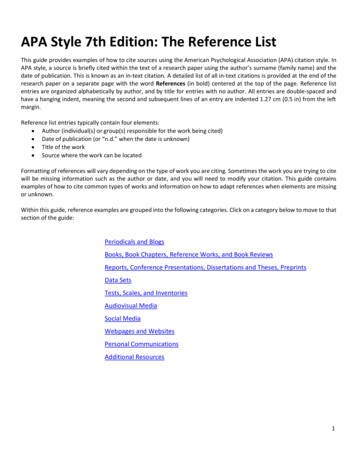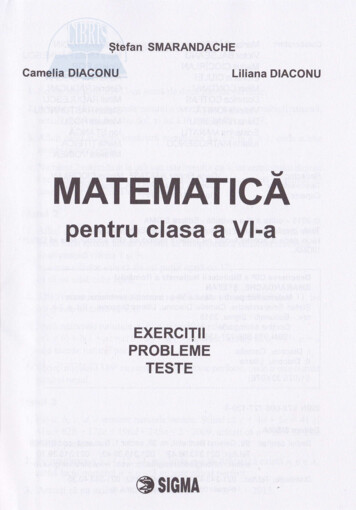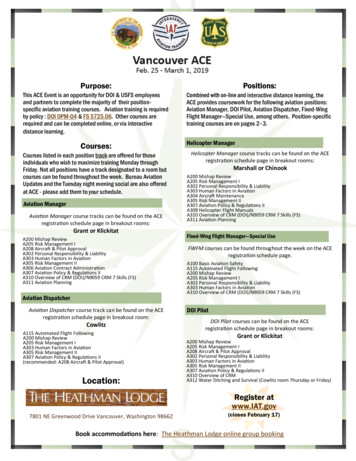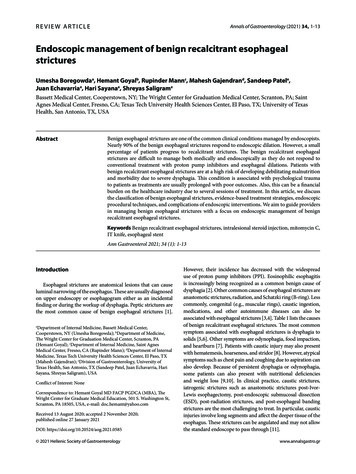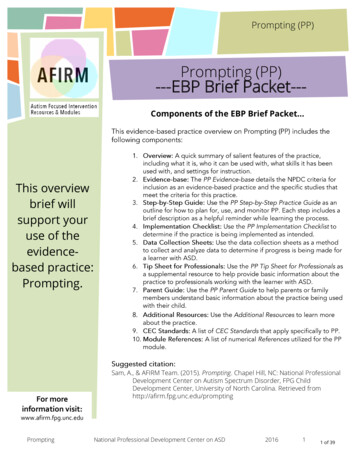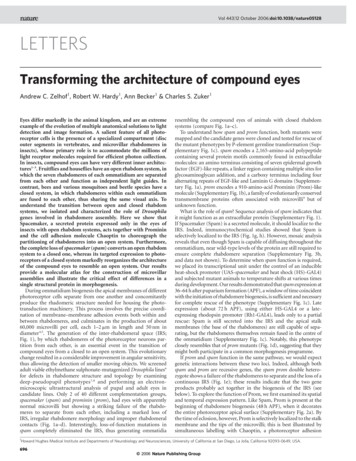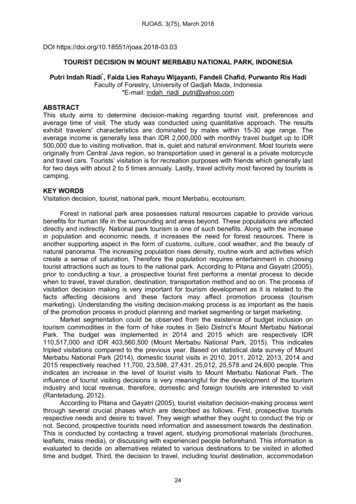
Transcription
RJOAS, 3(75), March 2018DOI https://doi.org/10.18551/rjoas.2018-03.03TOURIST DECISION IN MOUNT MERBABU NATIONAL PARK, INDONESIAPutri Indah Riadi*, Faida Lies Rahayu Wijayanti, Fandeli Chafid, Purwanto Ris HadiFaculty of Forestry, University of Gadjah Mada, Indonesia*E-mail: indah riadi putri@yahoo.comABSTRACTThis study aims to determine decision-making regarding tourist visit, preferences andaverage time of visit. The study was conducted using quantitative approach. The resultsexhibit travelers' characteristics are dominated by males within 15-30 age range. Theaverage income is generally less than IDR 2,000,000 with monthly travel budget up to IDR500,000 due to visiting motivation, that is, quiet and natural environment. Most tourists wereoriginally from Central Java region, so transportation used in general is a private motorcycleand travel cars. Tourists’ visitation is for recreation purposes with friends which generally lastfor two days with about 2 to 5 times annualy. Lastly, travel activity most favored by tourists iscamping.KEY WORDSVisitation decision, tourist, national park, mount Merbabu, ecotourism.Forest in national park area possesses natural resources capable to provide variousbenefits for human life in the surrounding and areas beyond. These populations are affecteddirectly and indirectly. National park tourism is one of such benefits. Along with the increasein population and economic needs, it increases the need for forest resources. There isanother supporting aspect in the form of customs, culture, cool weather, and the beauty ofnatural panorama. The increasing population rises density, routine work and activities whichcreate a sense of saturation. Therefore the population requires entertainment in choosingtourist attractions such as tours to the national park. According to Pitana and Gayatri (2005),prior to conducting a tour, a prospective tourist first performs a mental process to decidewhen to travel, travel duration, destination, transportation method and so on. The process ofvisitation decision making is very important for tourism development as it is related to thefacts affecting decisions and these factors may affect promotion process (tourismmarketing). Understanding the visiting decision-making process is as important as the basisof the promotion process in product planning and market segmenting or target marketing.Market segmentation could be observed from the existence of budget inclusion ontourism commodities in the form of hike routes in Selo District’s Mount Merbabu NationalPark. The budget was implemented in 2014 and 2015 which are respectively IDR110,517,000 and IDR 403,560,500 (Mount Merbabu National Park, 2015). This indicatestripled visitations compared to the previous year. Based on statistical data survey of MountMerbabu National Park (2014), domestic tourist visits in 2010, 2011, 2012, 2013, 2014 and2015 respectively reached 11,700, 23,598, 27,431, 25,012, 25,578 and 24,600 people. Thisindicates an increase in the level of tourist visits to Mount Merbabu National Park. Theinfluence of tourist visiting decisions is very meaningful for the development of the tourismindustry and local revenue, therefore, domestic and foreign tourists are interested to visit(Rantetadung, 2012).According to Pitana and Gayatri (2005), tourist visitation decision-making process wentthrough several crucial phases which are described as follows. First, prospective touristsrespective needs and desire to travel. They weigh whether they ought to conduct the trip ornot. Second, prospective tourists need information and assessment towards the destination.This is conducted by contacting a travel agent, studying promotional materials (brochures,leaflets, mass media), or discussing with experienced people beforehand. This information isevaluated to decide on alternatives related to various destinations to be visited in allottedtime and budget. Third, the decision to travel, including tourist destination, accommodation24
RJOAS, 3(75), March 2018type, travel method, and activities to be undertaken in the tourist destination. Fourth, travelpreparation and tourist experience by booking accommodation and travel method,conducting personal preparations, and finally carrying out the travel activities. Fifth, touristsdo an assessment on their travelling satisfaction. During the trip to tourist destination andafter returning to the country of origin, the tourists consciously or unconsciously alwaysevaluate their travel which will affect visitation decisions in the future.There are several factors that influence the decision-making process as described byPitana and Gayatri (2005):1. Tourist characteristics, both social and economic characteristics (age, education,income, and previous experience), as well as behavioral characteristics (such asmotivation and the value held)2. Awareness of travel benefits, knowledge of destinations to be visited, the image ofthe destination3. Trip features, including distance, stray duration, time and cost constraints,uncertainty risk, and the level of confidence in the travel agency4. The advantages of the tourist destination, which includes the type and nature of theattractions offered, service quality, physical and social environment, politicalsituation, accessibility, and local community attitude towards tourists. This is in linewith the regulation of Boyolali Regent No. 21 The year 2015 regarding work planBoyolali Regency Regional Development in 2016. One of which discussed thepotential of regional development for tourism, in increasing tourists decision inchoosing a tourist destination to Merbabu Mountain National Park.Therefore, this study was conducted to determine factors affecting tourist decision invisiting Mount Merbabu National Park. It is conducted in order to create tourismmanagement strategy in increasing tourist visits. The objectives of this research are asfollows:1. To determine tourist characteristics related to gender, age, income, origin, travel timein Selo hike route Mount Merbabu National Park2. To determine characteristics of tourist visit related to type, purpose, habit, thepreferred activity on the Selo hike route Mount Merbabu National Park.3. To determine the characteristics of tourists budget utilized to travel to MountMerbabu National Park4. To determine infrastructure facilities found in the Selo Hike Route Mount MerbabuNational Park.The research result could be used as ecotourism information development of MountMerbabu National Park, Selo District, Boyolali Regency.METHODS OF RESEARCHThe location of the study was determined by puIDRosive sampling (as the purpose ofthe study), at Wonolelo Resort Selo Hike Route in Selo District Boyolali District. Based onthe revised zonation document of Mount Merbabu National Park (2014) as stipulated inForestry Ministerial Decree number 135 / Menhut-II / 2014, it is an area of 5,725 hectares,geographically located at 1100 32 'BT - 1100 48' BT and 70 38 'LS - 70 48'LS. This area hasthe highest peak at 3,142 meters from sea level. Topographic range from light tomountainous (slope starts from 8% to above 40%). The study was conducted in Septemberand October 2016.Research Sample. Research respondents were tourists who visited Mount MerbabuNational Park, Boyolali Region within the limit of data collection period for 2 months using indepth interview and research questionnaire. The number of research samples is determinedbased on the consideration of the Slovin formula, namely:n 1 25
RJOAS, 3(75), March 2018Where: n total sample; N total population (140 people); e toleratable sampling mistake(5%).Total tourist sampling formula:n 1 140140140 100 tourist1 140 (0,050)1 0,401,40Tourist samples obtained were 100 tourists. These provide narrative and generaldescription of tourist decision to visit Merbabu Mountain National Park.The sampling method is carried out by accidental sampling. Researched selectedtourists who are in the research area and willing to complete the questionnaire and beinterviewed in detail. Respondent selection is based on several factors such as being inproductive age of at least 15 years, able to receive and respond to questions asked directly,the level of income used for students and unemployed is the amount of money (in the formof allowance, grant, scholarship, prize) obtained, physically and spiritually healthy, and cancommunicate well.Data Analysis Approach Method. Data analysis approach method utilized is a mixtureof quantitative and qualitative methods (mixed methods research). This approach methodcombines qualitative methods with the support of quantitative methods aimed at obtaining acomplete picture and a thorough understanding (narration and data in numbers). Based onthe results of the research data analysis approach, the researcher can clearly explain thecharacteristics of tourists, visits, budgets, supporting facilities and infrastructure of MountMerbabu National Park.RESULTS AND DISCUSSIONTourist Characteristics. In general, tourist characteristic in Selo Hike Route is touristspossessing conventional psychographic characteristics. Conventional psychographiccharacteristic is are people demanding perfection of service and completeness of tourisminfrastructure (Weiler et al., 1992). It was seen from tourists effort to visit Mount MerbabuNational Park Ecotourismby setting aside their spare time, preparing equipment andsupplies, as well as route planning.Table 1 – Tourist Characteristic CategoryNo.Tourist Characteristic1Gender2Age3Income4Place of Origin5Travel TimeCategoryMaleFemale15-20 years old21 - 30 years old 30 years old0 IDR 2.000.000IDR 2.000.000 - 5.000.000IDR 5.000.000 - 10.000.000IDR 10.000.000 - 20.000.000West JavaCentral JavaEast JavaSouth Sumatera 2 hours2 - 4 hours 4 ce: Research primary data (2016).Gender Characteristic. Tourist decisions are also influenced by personal variables(Kotler, 2005). These characteristics include aspects such as age, life cycle stage,occupation, economic situation, income, and lifestyle. Gender characteristic information is26
RJOAS, 3(75), March 2018required to determine dominant tourists in order to produce activities planning to beconducted at Mount Merbabu summit during camping. The results of this study analysis aimto determine the type of tourist attraction favored by tourists based on gender/sex that comeSelo hike route in Mount Merbabu National Park. Most tourists are males (86%), while theremaining 14% are women. This is caused by men’s physical strength that are moreproductive than women. This is in line with Tazkia’s statement (2012) that male tourists(60%) are more dominant than female by 40% at hot springs tourist attraction in Wonosobo.Age Characteristic. Information on age characteristic is required to determine thedominant age of tourists to be used as a promotional target of ecotourism developmentprogram plan. Based on the research result, tourist visiting Selo Hike Route are within agerange 20-30 years (51%), 15-20 years (48%), and tourists aged 30 years (1%). Youthstamina between 15-30 years is higher than those aged at 30 years. Therefore, theaverage tourist aged 20-30 has a suitable market on this tour, with activities such as transferof knowledge related to agricultural activities of various types of horticulture other than hikingactivities. Tazkia (2012) stated that tourists are dominated by respondents who are inproductive age at an average of 15-29 years. Similarly, in Nahriya’s research (2015), touristsin Umbul Songo are mostly male (53%) with age range within 21-25 years. Similar touristcharacteristic is caused due to most tourists are within 20 to 30 years age range. Thesetourists are relatively healthy, concentrated on the association of friends, not having family orsmall children. Therefore activity chosen is to enjoy the beauty of nature by performingvarious challenges in the hike route.Income Characteristic. Information on tourist income characteristics was determined todetermine tourist categories capable of spending the time to travel with appropriate budgettype. Research result exhibits income level of IDR 2,000,000 (63%), IDR 5,000,00010,000,000 (22%), IDR 2,000,000-5,000,000, IDR 0, and IDR 10,000,000-20,000,000 at 1%respectively. Most tourists are within category IDR 2,000,000, as this category isdominated by students and college students who obtained an allowance from their parents.The group of IDR 5,000,000- 10,000,000 was dominated by workers. This is in line withPrasetyo’s research (2013) stating that tourist income averaged at IDR 1,645,667.According to Keliwar’s statement (2015), the average income of tourist visitingPampang Samarinda cultural village is generally more than IDR 3,000,000 (32.1%). This isdue to the uniqueness of Pampang cultural attraction such as the existence of a historicalbuilding architecture, sculpture, beads craft, dances, and traditional Dayak musicalinstruments. Therefore foreign tourists or domestic tourist from outside the island have agreater interest. In contrast to tourists in Selo hike route, these are generally dominated byadolescents to adults levels possessing intermediate level of income.Place of Origin Characteristic. Place of origin characteristic information is needed todetermine the level of promotion and tourists’ curiosity in Mount Merbabu National ParkEcotourism. Research result exhibits that most tourists were originated from Central Java(53%), West Java (21%), East Java (15%), and South Sumatra (11%). Tourists come fromCentral Java and East Java possess better accessibility compared to others as they wouldneed to spend less time to travel to the National Park. Tourists from West Java and SouthSumatra visiting Mount Merbabu National Park is led by their curiosity in seeing thedifferences on available attraction compared to tourist areas in their home region. Accordingto Keliwar’s research (2015), Pampang cultural village is mostly visited by tourist hailing fromSamarinda (51.8%). This is similar to tourist in Mount Merbabu National Park coming fromCentral Java (53%), who is basically originated from the same province as the National Parkitself. According to Wanti’s research (2014) tourists in Kina Bukit Tanggul garden comesfrom Bandung (66.67%) and Sumedang (3.33%).All this proves that most tourists come from the city where the tourist area is located. Itcan be concluded that Kina Bukit Tanggul does not have high promotion level andattractions diversity. Most tourist attractions are visited by tourist from the same region it’slocated at and regions within close proximity. Closer distance allows the tourist to applyoptimal travel time and budget. Selo Hike Route tourist is originated from regions with adistance of more than 80 km or 1.5 hours travel time (47%). It indicates that Mount Merbabu27
RJOAS, 3(75), March 2018National Park has a unique attraction on the flora, fauna, cultural arts architecture, music ortraditional dances, as well as the diversity of agricultural horticultural crops.Travel Time Characteristic. Information on travel time characteristic is needed todetermine tourist level of curiosity to visit the ecotourism area Mount Merbabu National Park.Research result exhibits tourist had to go through travel time 4 hours (50%), 2-4 hours(28%), 2 hours (22%). Tourists who traveled 2 to more than 4 hours visited Mount MerbabuNational Park due to unique scenery not owned by other National Parks. Tourists whotraveled 2 hours and less were driven by the desire to conduct vacation in optimal timeallocation.According to Tazkia’s research (2012), the average tourist tourist who traveled 5 km orless than 10 minutes from their residence or place of origin. This is dissimilar compared totourist visiting Mount Merbabu National Park. In general, tourists had to travel 180 km or240 minutes to reach their destination, assuming that they traveled 30 km in 45 minutes.Therefore tourists are more attracted to visit Mount Merbabu National Park than hot springsin Wonosobo.Tourist Visit Characteristic. In general, a tourists visiting Selo Hike Route in MountMerbabu National Park are those with conventional psychographic characteristics.Conventional psychographic characteristic is a character that demands perfection of serviceand completeness of tourism infrastructure (Weiler et al., 1992). It can be seen from touristvisit to ecotourism area in Mount Merbabu National Park by considering various things suchas: with whom they make a visit, visitation purpose, stay duration, factors encouraging theirvisit, and preferred activity.Table 2 – Tourists Visitation Characteristic CategoriesNo.Tourist Visitation Characteristic1Type2Purpose of Visit3Behavior4Length5MotivationVisitation Category1 person2 - 5 person6 - 8 person 8 rtBusinessCultureWork AssignmentFamily Visit1 time2 - 5 times 5 times1 day2 days3 daysClose DistanceEasinessAdequate TransportLow ExpenseNature Potential and AttractionQuiet and Natural EnvironmentTrackingHikingCampingEducationStar ObservationReligion6Preferred ActivitySource: Researcher Primary Data 496413446205261726085152313
RJOAS, 3(75), March 2018Type Characteristic. Information on the tourist visit type is needed to determine thelevel of promotion and curiosity on Mount Merbabu National Park Ecotourism. The analysisresults exhibit that tourists come in 2-5 group members (40%), 6-8 group members (30), 8group members (20%), and 1 person (8%). Tourist mostly comes in 2-5 group members. Ingeneral, there are couples who want to enjoy the scenery of Merbabu National Park. Groupconsisting of 6-8 people or more are a group of students and university students intent toexperience adventure dissimilar to other attractions in other tourist destinations. According toTazkia's research (2012), in general, tourists visit in a group or bring their family for the trip.This is similar to tourist visiting Selo Hike Route in Mount Merbabu National Park. In general,they visit in 2-5 group members. This is in line with Premono’s research (2008) stating thattourists visit TWA Punti Kayu with relatives or friends (57%).Purpose of Visit Characteristic. Every tourist has a purpose or occasion to travel toSelo Hike Route in Mount Merbabu National Park. Based on the research result, the touristhas the following purpose or occasion: holiday (75%), recreation (53%), sport (46%), andhealth (42%). Education, family visits, work assignments, religious, business, and culture arerespectively 18%, 16%, 11%, 6%, 6%, 6%. Tourists visiting for holiday and recreationpurposes generally come on weekends and public holidays such as Javanese New Year.According to Rizkhi’s statement (2014), tourists on Palu Bay tour travel to their respectivedestination to enjoy the nature while on recreation to exercise, refresh, reflect fatigued bodyand mind due to daily activity, and restore health (78,99%). In general, tourists visiting SeloHike Route and Palu Bay come for vacation purposes. Nahriya’s research (2015) stated thatmost tourists in Umbul Songo come with recreation and vacation purpose (36%). ThereforeUmbul Songo tourists have similar purposes to those visiting Selo Hike Route. Holidays canbe classified into weekends (Saturday and Sunday) and public holidays which are commondays for tourist to visit.Behavior. Information on tourist behavior in one year is needed to determine the levelof tourist satisfaction in ecotourism area of Mount Merbabu National Park. Research resultexhibits that tourists generally conduct 2-5 visits per year (53%), 1 visit per year (44%), andmore than 5 visits a year (3%). In general tourist visits Mount Merbabu National Park 2-5times a year which indicates that these tourists generally return to this tourist attraction. Theywere drawn by available attractions, objects, beautiful scenery, and distinct cultural aspects.Based on Prasetyo’s research (2013), Mount Merbabu National Park tourists visit 2 timesannually which is more compared to those visiting tourism village. According to Tazkia(2012), tourists visit Wonosobo hot springs around 1 to 5 times, which is similar to Selo HikeRoute in Mount Merbabu National Park. According to Nahriya (2015), Umbul Songo touristsgenerally revisit the tourist destination (70%). Therefore both Umbul Songo and Selo HikeRoute tourists possess similar desire to return to a respective tourist destination.Variety of scenic beauty can be seen from the planting activities of various types ofhorticultural crops along Selo Hike Route. This motivation that causes tourists to return,therefore the natural potential of nature in the form of horticulture species diversity can be apotential development of agrotourism in Merbabu Mountain National Park. This is in line withKoswara’s research (2005) stating that tourists’ dynamically growing preferences andmotivation as well as the tendency of tourists visit natural environment led to thedevelopment of agro-based tourist attraction.Duration Characteristic. Information on tourists’ stay duration is needed to determinethe tourists’s stay duration in Mount Merbabu National Park Ecotourism. Research resultexhibits that tourists generally stay around 2-days (49%), 1-day (45%), and 3-days (6%).The tourists generally stay for two days starting from Friday night to Sunday morning.Tourists who stay for one day come from a distant area therefore having limited time tospend in the location. There are also tourists coming from nearby regions who ridemotorcycles to tourist attraction hence having limited time constraint as well. Nevertheless,in case of 3 days visit is generally caused by heavy rain occuring during the trip. Thereforethe tourists had to extend their stay. According to Sitohang’s research (2008), touristsgenerally visit Tuktuk Siadong in Simanindo District for more than 72 hour (49%). Their stayduration is longer compared to tourist in Selo Hike Route who generally stays for 48 hours29
RJOAS, 3(75), March 2018(48%). Tuktuk Siadong tourists come from abroad. These international tourists are interestedto participate in events featuring cultural diversity, landscape, and community social life.They generally spent more than 24 hours. On the other hand, tourists on Selo Hike Routeare merely enjoying the scenery in Mount Merbabu. According to Nahriya (2015), mosttourists in Umbul Songo area around the springs of Mount Merbabu National Park KopengResort does not spend the night, but merely conduct activities for one day (77%). In contrastto tourists visiting Mount Merbabu National Park, most conduct activities for 2 days as thereare various activities along Selo Hike Route which could consume at least 14 hours.Motivation Characteristic. Every tourist has the motivation or encouragement to travelto Selo Hike Route in Mount Merbabu National Park. Marsinko et al (2002) state that anindividual's recreational visit is based on expectations of the activity benefits. Researchresult indicates that most tourist visiting Selo Hike Route in Mount Merbabu National Parkare drawn by a quiet and natural environment (61%), natural potential and attraction as wellas the local community (52%). Adequate transportation, close proximity, easy access toclimbing routes, and low cost are 46%, 41%, 34%, 20% respectively. Tourist is generallymotivated by nature potential and human attraction, as local community conduct ‘culturalwisdom' activities such as New Javanese year, Saderanan (cemetery cleaning andmaintaining ritual), Sedekahan (feast) and so forth. Adequate transportation is supported byadequate transportation facilities such as travel vehicle rental and motorcycle. Furthermore,the low cost incurred is reflected in admission fee, accommodation costs, or snacks withaffordable prices for low to high society member.Tourist is attracted to natural potential and attractions such as the various types ofagricultural horticulture crops planted. There are chilies, cabbage, tomatoes, green onions,carrots, pumpkin on farmers' land which can be seen from along the main road of SeloDistrict up to the hike route itself. Nature attraction exhibits farmer activity conductingplanting, maintaining, or harvesting horticulture crop. This activity can be used as educationmedia and promotion of the agricultural product for tourists. In line with Koswara’s statement(2005), agrotourism is one type of tourism that utilizes agricultural business as a touristattraction, combining agricultural and tourism activities. This provides a signal for thedevelopment opportunities of diversification of agribusiness products which means it wouldencourage new development area for the region.According to Tazkia’s research (2012), tourists’ motivation is low expenses, which isdissimilar to tourist visiting Selo Hike Route in Mount Merbabu National Park. They aredrawn by the presence of natural and human attractions as well as potential. According toKastolani’s research (2016), tourists possess physical and psychological motivation level at37.68% in Cimahi tour. Cimahi tourist motivation is lower compared to those in Selo HikeRoute, which is caused by similar tourism objects such as community agricultural andlivestock caretaking activities. Nevertheless, Selo Hike Route's especially featured climbingand camping activities as well as observing flora and fauna from the summit of MerbabuMountain.According to Nahriya’s research (2015), Umbul Songo Mount Merbabu National Park'stourist is influenced by tourism activities factors. Most tourists have never visited the location(5.4); colleague or family invitation (5.6) which has a somewhat influential meaning. Thehighest driving factor for visiting Umbul Songo is family and friend invitation (5.6). On theother hand, the highest driving factor for tourist visiting Selo Hike Route is drawn by thebeautiful scenery and villages’ natural condition (61%).Preferred Activity Characteristic. Every tourist has the motivation or encouragement totravel to the Selo Hike Route in Mount Merbabu National Park. Research result exhibitstourist are interested in camping activity (85%), tracking (72%), hiking, animal, educationalreligious observations are 60%, 23%, 15%, 13%, respectively. Preferred activities such ascamping enable tourists to spend time at the top of the mountain with relatives and watch thesunset. Tracking activity enables tourist to determine relatives' character during undesirableevents. Tourists can also enjoy the trip by looking at various types of forest plants andbeautiful fauna. Introduction of flora fauna ecosystem types in Mount Merbabu National Parkis conducted by tour guides while on a trip or at posts alongside the hike route. According to30
RJOAS, 3(75), March 2018Sitohang’s research (2008), Tuktung Siadong tourists have an average level of interest intourism program activities during Visit Indonesia Year 2008 (61.6%). Tuktung Siadong touristinterest rate (61.6%) is smaller compared to Selo Hike Route (85%) interest rate towardsavailable attraction. Selo Hike Route offers natural beauty and challenges that encourageadrenaline rush.Expenses Characteristic. Information on Expense characteristics is required to view orestimate the expenses incurred during a trip. Iqbal’s research (2006) states that travelexpenses consist of transportation costs (travel and return trip), accommodation (lodging)costs while on site, consumption fee, entrance fee, and other expenses. Semet’s research(2012) states that the travel expenses consist of transportation costs, accommodation costs,consumption costs and communication costs.Table 3 – Expense CharacteristicNo.Expense Characteristic1Monthly Budget (/budget)2Income (/budget)Category IDR 500,000IDR 500,001 – 1,000,000IDR 1,000,001 – 1,500,000 IDR 2,000,000IDR 2,000,001 – 5,000,000IDR 5,000,001 – 10,000,000Percentage55331273243Source: Researcher Primary Data (2016).Budget Characteristic. A number of expenses incurred by travelers reflect the touristWTP (income) for recreational services. Individual assessment of a recreational visit isbased on expectations of activity benefits (Wijayanti, 2009). Research result exhibit thattourist allotted monthly travel budget around IDR 500,000 (55%), IDR 500,001-1,000,000(33%), and IDR 1,000,001 -1,500,000 (12%). Tourists with IDR 500,000 budgets are mostlystudents or university students. They generally drive from their residence to touristdestination less than 4 hours. Tourists with budget category IDR 500,001 -1,000,000 arestudents and workers residing in regions required more than 4 hours of travel. Thereforethese tourists required to amass a certain amount of money prior to travel. Tourist withbudget category IDR 1,000,001-1,500,000 generally resides in the region requiring morethan 4 hours of travel. Nevertheless, they have relatives living in the nearby region whichrequires less than 4 hours of travel, therefore these tourist spends more than 2 days.Average Mount Merbabu National Park tourist budget is IDR 500,000 but more thanIDR 120,000. This is reinforced by the assumption tourists’ expenses for 2 days 1 night is atleast of IDR 120,000. According to Prasetyo’s research (2013), average tourism villagetourist budget is IDR 103,333. According to Menuh (2016), backpacker tourists spendaverage budget costs incurred to travel to Bali around IDR 117,250 a 1 day. Backpackertourist spending in Bali is 1.5 times greater compared to Selo Hike Route's tourist expenseswhich amount to IDR 60,000 per day. Balinese living cost is higher than the villagers in Selodistrict. According to Nahriya (2015), Umbul Songo tourist travel costs are in the range ofIDR 100,000 – IDR 200,000 (43%) and IDR10,000 to IDR 50,000 (37%). Average UmbulSongo tourist’s expenses are almost the same as Selo Hike Route Mount Merbabu NationalPark tourist which reached IDR 200,000 As average
(60%) are more dominant than female by 40% at hot springs tourist attraction in Wonosobo. Age Characteristic. Information on age characteristic is required to determine the dominant age of tourists to be used as a promotional target of ecotourism development program plan.

